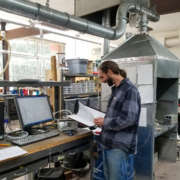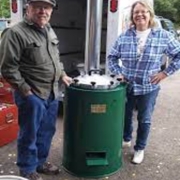New Video: Test Kitchen 2021 Natural Draft Hood
The old saying, “if you can’t handle the heat, get out of the kitchen,” is not lost on us when we are working in the test kitchen. It takes us a while to get the vertical and horizontal grid of Climate Solution Consulting’s HAPEx particulate matter monitors started and positioned. Then ARC’s PEMS-PC partial-capture based emissions sampler has to collect a zero point of the gasses in the atmosphere. Don’t forget the temperature sensors (where is that data?) and the wood. This is after reviewing yesterday’s work, discussing a plan for the day, and watering the garden. So, by the time the young scientist rolls into the test kitchen in the Oregon summer, currently home of America’s largest wildfire, it’s about 100°F and rising. But science must go on.
ARC’s four year old test kitchen is currently being used to test a natural draft hood of our design. Our experiment allows us to operate the fire without being exposed to the emissions from the fire. We used to use a vacuum cleaner as a positive pressure ventilator, but now we sit outside of the room and feed the fire through a glove box. After seeing that the hood was effective enough to reduce the concentration of PM2.5 in the test kitchen to below 35 ug (averaged over 24 hr), we turned the hood around and made a video for you of us doing the water boiling test while enjoying a smoke free kitchen.
Enjoy the video (and know that those loud pumps and fans go with the bit about it being hot in the kitchen).
Please send your photos and stories of natural draft hoods! We don’t want to lose this beautiful technology.
-Sam Bentsen, Aprovecho Research Center General Manager









